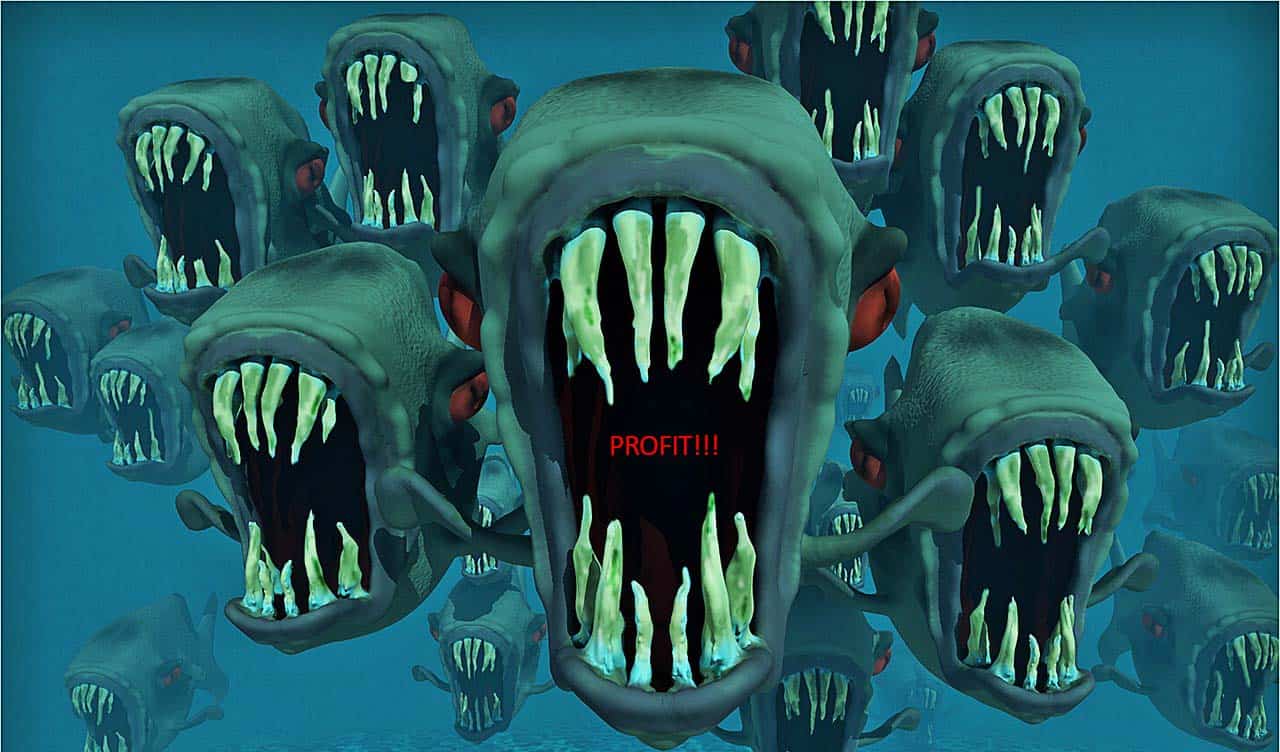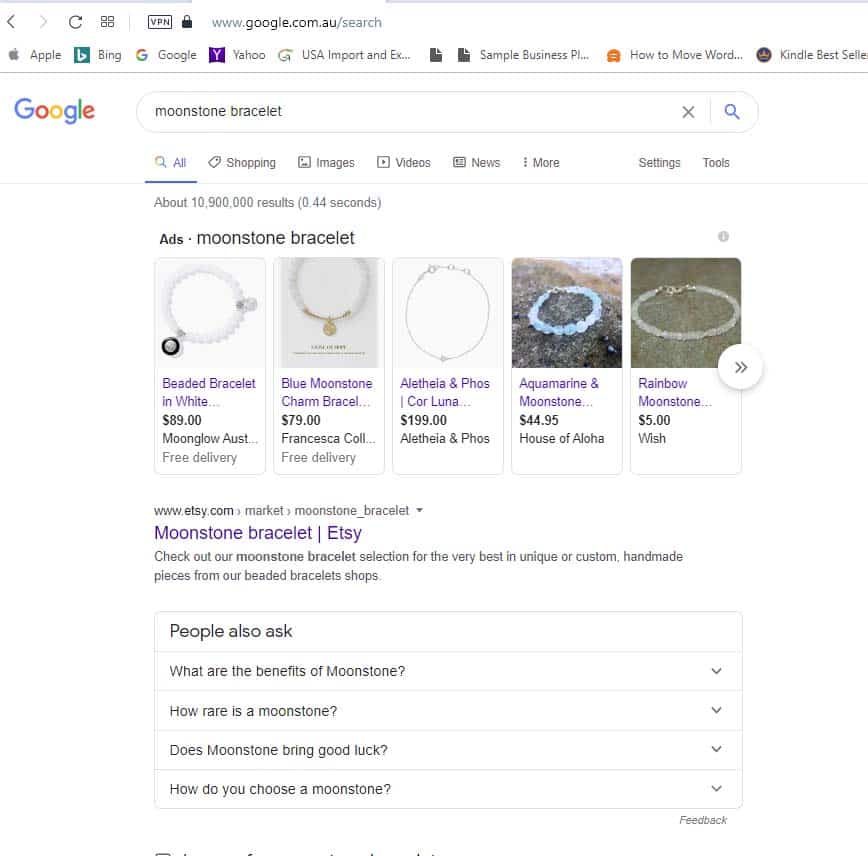Calculating Online Investment and Profit for an eCommerce Business Website
Right now, it seems that every man, woman and pet monkey wants to jump into eCommerce with an eCommerce Business Website and get their business online. And why not? Many of the changes caused by the Covid pandemic will be permanent. Are you ready for the challenge?
A Typical Business Moving Online
We have built online properties of various types, including eCommerce Business Websites for a range of companies. But we can't write an article about them all, so in this article, we'll focus on one type of company , and refer to others as helpfully as we can. We'll doubtless write full articles on other types of business soon.
Welcome To Julie's Home Jewelry
Julie lives in Sydney. She's been retailing and making beautiful home-crafted jewelry for a few years and selling through local stores and a network of friends. In particular, her moonstone bracelets are selling well. She wants to grow her business without the expense of opening her own store and to take a greater profit than she does from local stores. She has a reliable supplier and wants to increase sales - the capacity exists but the sales channels are not sufficient.
The latter point is important -
First Considerations for an eCommerce Business Website
Current Business Summary
Selling Price | Cost price | Gross Margin | |
|---|---|---|---|
Average product | $45 | $10 | $35 |
Let's say that July is selling 50 of these moonstone bracelets per month, and has the capacity to supply another 150/month. This seems like a good opportunity. But is it? At those prices, she stands to gross an additional $5,250/month (Gross Profit before advertising costs) if she can sell all of them. Let's take a closer look at this.
What Julia wants to Sell Online
Julia is selling a Moonstone Bracelet as shown here:

Image belongs to WISH - Follow link to buy! (We do NOT own this image or product)
Goals for Julia's eCommerce Business Website
- 1To sell 150 Moonstone Bracelets per month
- 2To plan and achieve a net profit of $20 per item minimum (allowing $15 per item for advertising costs)
- 3To sell the bracelets nationally across Australia, not just locally as she is currently doing.
Getting Business Started Online : The First Mistakes
This is where 99% of business people make a huge mistake and immediately lunge to buy an eCommerce Business Website. Then they make the second mistake and immediately search for the cheapest supplier.
"Do NOT Assume You Need an eCommerce Business Website - Do the Numbers First" - Keith Rowley
Things to Consider before an eCommerce Business Website
The only objective of a eCommerce Business Website is to get your product in front of customers. No matter which method you choose, you will face competition. Here are some methods of presenting your products online along with the main methods you can use to promote them. As you will see, we do NOT recommend all the options in the table, but they are there so that we can explain.
Online Sales Platforms and Promotion Methods
Sales Platform | Promotion Method 1 | Promotion Method 2 | promotion Method 3 |
|---|---|---|---|
eCommerce Business Website | Facebook Ads | ||
Shopify Store | SEO | Google Ads | Facebook Ads |
Amazon Store | Amazon Ads | SEO | Google Ads |
Facebook Store | Facebook Ads | SEO | Google Ads |
The Facebook Store
Here are the key points for selling products on Facebook:
"To sell products on Facebook, you first need a dedicated Facebook page for your business (not your personal page). Next, either connect your ecommerce platform to Facebook or upload your product category manually. Then, you’ll have to market your products and your Facebook Shop through ads, contests, and boosted posts." - Fitsmallbusiness.com
So it's clear that you need an eCommerce platform (eCommerce Business Website or other options as noted below) to enable setting up a Facebook shop. We therefore consider that a Facebook shop is a great place to expand your shopping efforts to, but is not your first point of call to establish online sales. However, unless you live in the USA, you cannot accept payments on a Facebook shop, so even with a Facebook shop, you need another platform.
A Shopify Store Platform
This is a popular way to set up a eCommerce Business Website. We won't go into the technicalities here as our focus is on cost, save to say that we think that most people who are comfortable with computers should be able to set up a basic store without help.
The basic costs US$30 per month (AU$43/month). However, that is basic and as soon as you learn about other features needed to make your store more attractive and improve conversion, you start paying for plugins' that charge a monthly fee. We found that our monthly bill easily increased to around AU$75/month which is A$900 per annum.
Of course, there are other eCommerce Business Websites stores like Shopify you can use, but for cost illustration purposes, we'll stop at that and move on. The key point is that Shopify will cost you around A$900 per annum - forever!
Selling on Amazon FBA and Self-Fulfillment
Selling on Amazon is a journey and requires considerable time to learn how to get products into the store, price them properly and advertise. A professional Amazon account costs US$40 or A$57 monthly - but that's just an admin fee so we need to take a closer look and at the FBA program and seller-fulfillment in particular.
The Amazon FBA Program means 'Fulfilled by Amazon' which means that once your items have been received into Amazon's warehouses, Amazon takes it from there and takes orders, delivers and so on. With 'Your Fulfillment' you sell on Amazon but ship yourself.
However, Amazon also provides refunds to customers at the drop of a hat, and you have to factor in such losses. Here is a Amazon FBA and 'Your Fulfillment' calculation. The cost of the product to Julie is shown as $10 - the rest is self explanatory.

On the surface this looks great, either with or without FBA but here are the problems we found when selling on Amazon instead of of selling on our own eCommerce Business Website.:
Amazon Ad Costs
The key point to note in this example is that net profit is now around $23 - $26 per item depending on FBS or non FBA sales. The profit target that Julie has is $20 per item, and before advertising, she meets this. But she will certainly NOT meet this target when Amazon advertising costs are added.
In this project, Julie wants to sell 150 items per month. Let's assume that that's 5 per day. At five per day, and $20 profit each we see $100 per day total profit after Amazon costs. Our experience shows us that we would need to spend at least $50. Here are some independent numbers from another cool site, shoppingfeed (converted to A$):
Those figures are critical. A click does not mean a sale. Let's say you get 10% conversion from clicks to sales (which is very good), then each sale will be costing you $13.80. Julies's net profit has now dropped to $6.20. If the conversion rate is 5% (which we think is normal for most products) then Julie is running at a loss.
We've been through this with a $10k branded product investment and despite working the numbers quite assiduously, we lost money.
The Upside of Amazon vs an eCommerce Business Website
The Downside of Amazon

On our first attempt at selling a branded product from China, we invested around $10k and lost about 25%. We were novices and we could have done better. We also entered the most competitive niche on the whole site - Essential Oils and Diffusers. Try it with a slow start if you go this route! We suggest an initial investment no greater than $500 for newbies - and write that off as school fees just in case!
Your Own eCommerce Business Website
This is often, and quite naturally, the first port of call for those starting off their eCommerce adventure. We're going to start by referring you to our article on what an eCommerce Business Website is so that we don't repeat ourselves here. Just click on the image to catch up if you need to:
eCommerce Business Website Cost
A competently built eCommerce Business Website will cost around $4000 from most reputable and capable design houses. This is a capital cost that you can write off against taxes over three years. The design house may include hosting, logo design and support or may not - be sure so that you don't have unbudgeted costs. Here's a list of factors that will determine costs:
So you have your website up, and the running costs are known. What are the other expenses and how do you make a profit? These tables will help and should be self-explanatory. First though, some typical data if we advertise on Facebook:
- 1Facebook Ad Cost per Thousand Views (CPM): $25 (which is reasonable for a good ad despite what others say - we've been running ads for years. our ads usually start at a CPM of up to $80 which decreases over a couple of days for our best ads.)
- 2Facebook Ad Clicks per Thousand Views at 5% Click Through Rate (CTR) - this is good. The average CTR for all industries is 0.9%
- 3Daily Ads Budget $50 (work up to this and more after finding an ad that works. In general start on $10/day)
- 4For our daily budget, we get 2000 views per day and 100 Clicks
So we have purchased 100 clicks per day to our product on out website. But what is our website conversion from visitors to purchasers? Across industries, the average landing page conversion rate was 2.35%, yet the top 25% are converting at 5.31% or higher (Wordstream). We'll work on 2.0% for convenience.
This gives us 2.0 sales for our $50 daily budget. At a pre-advertising GP of $35 per product we have a profit of $70-$50 = $20.
The important thing about this result is that you have an ad that is at least profitable and as such it can be scaled up. A good Ad with lots of comments and likes will drop the CPM a lot - maybe down as low as $8 when it really gets going.
Free Ads Profit Calculator (Use for Facebook or Similar CPM Ad Platform)
This should be useful for you. Just enter data as you would for any calculator - it's live and it works.
So let's see where we are with Julie now and enter the following numbers into the calculator above:
Done it? What the numbers show is that at these performance levels, Julie is selling one product a day at a cost of $20 in advertising. So her net profit is now $15 reduced from $35 and she's only selling one per day.
Reducing the Ad CPM and Increasing the Budget
Now let's assume the ad gets better and better over a few days and the algorithm learns, and keep the budget the same but drop the CPM cost to $15.
What we now see is that sales are two per day, with a net profit each of $26.75 or $53 per day.
Your eCommerce Business Website profitability is hugely dependent on the quality of your ads and the resultant CPM on Facebook!
But Julie needs to sell 5 per day, so we need to increase the advertising budget - now that we know the ad is profitable - not before! Using the calculator with the daily budget set to $50/day.
We now see the following:
NOTE: IF YOU USE FACEBOK ADS ONLY INCREASE THE DAILY AD BUDGET ON AN AD THAT PEFFROMS WELL BY ABOUT 10% - 15% PER DAY. IF YOU INCREASE TOO MUCH TOO SOON, THE AD WILL START IT LEARNING PHASE ALL OVER AGAIN AND SALES WILL DROP - ANFD MAYBE NOT RECOVER.
That's enough on Facebook!
Using SEO Profitably on an eCommerce Business Website
SEO profitability calculations are a bit more involved but still essentially simple. We use arithmetic not mathematics! Here is the starting sequence of activities before Julie or you should spend anything at all. bear in mind that SEO campaigns take 2 to 3 months to show results - just the first movements in your ranking.
Let's look at some examples.
Example SEO Calculations for Profitability on an eCommerce Business Website
Keyword | Search Volume (Semrush) | Difficulty/ Competition | Cost Per Click A$ (Google Ads) |
|---|---|---|---|
Moonstone Bracelet | 210 | High (82%) | 0.45 |
Georg Jensen Moonstone Bracelet | 90 | medium (50%) | 0.0 |
Moonstone Engagement Ring | 50 | High (80%) | 0.0 |
What we have here is a very competitive, very low volume keyword. It's competitive because it's a definite product that people search for and it has no geographical anchor for the seller, so the competition is nation-wide. Furthermore, the search results page are an absolute nightmare for a seller using normal SEO. look at this:

The whole top of the page is dominated by ADS. After that, the top ranking site is etsy - a major player that's very, very hard to beat - and simply not worth the effort with this product.
In a nutshell, this product will simply not make money from SEO investment and it's hard to see how the advertised products do either! Remember - those search numbers are monthly nationwide for Australia!
What Should Julia Invest her SEO Spend in then?
Unless she has a highly profitable product with high search volumes, Julia needs to go both local and generic. She should not be spending money on SEO for this product, but rather using advertising to profit from impulse buyers. If she wants to benefit from SEO she needs to define:
Having done these things, Julie should plan an initial six month SEO exercise, using the methods shown above, planning costs and profit every month.
Conclusions
Never 'jump' into an eCommerce adventure without a full-on business plan that includes investigation into the sales channels available. It's that simple - and that hard. Have fun.
CONTACT SYDNEY BUSINESS WEB NOW!
get started online NOW with your ONLINE BUSINESS ENGINEERING





